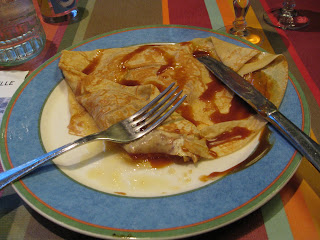Snow has finally come in large quantities on the mountains. This is the view from our bedroom window. Last week we received about 3 days rain in Grenoble, which, to the delight of skiers, is all snow at 2000 meters. Otto and Luc and willing Calvin students did go skiing on Saturday and had a great day.

This past weekend we decided to do a total market meal. Otto and I went to the market, not sure what the menu would be. This is what we came up with:
Pink trout (caught locally), zucchini and tomato and shallots for a sauce with the fish, bread, wine, 2 local cheeses, salad (grown just outside of Grenoble), and spice bread with clementines for dessert.

These are the bags you put your fruits and vegetables in. The bag advertises "Eat 5 fruits and vegetables a day for health and vitality.

Through school, Luc participated in a rock-climbing competition. Although his level didn't win, it was a good challenge. Luc is the the person nearest to the top.
A potluck with the volunteers at L'Echoppe--the food pantry where I volunteered this past semester.
I have seen a number of these dutch-made bikes around the city. Kids are strapped in the front carrier, along with some extra space for groceries, etc. I have also seen this bike with an attachment behind the seat to put a baby carseat!

Chocolate and pastry shops are full of these kind of gifts at this time of year. This is a tray of chocolates and almond-based treats that Otto received from one of the French ladies that housed a Calvin student. Anna loves the colored almond treats in the middle and we all (except Luc) love the chocolate.

















































